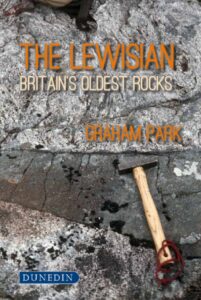by Graham Park

Recently, I have finished the Great Silurian Controversy, a magnificent book about the nineteenth century arguments over the age of the lower Palaeozoic greywackes/sediments of Devon, and the creation of the concept of the Devonian. And reading The Lewisian: Britain’s oldest rocks by Graham Park, it occurs to me that this should perhaps be called, The Great Lewisian Controversy. It shares the same historical and scientific intentions, and the same grand sweep of scientific history, this time from the early twentieth century – namely, the exploration over decades of the geology of the Lewisian of northwest Scotland.
That is, the book covers the early ideas from the 1907 Geological Survey Memoir by Peach, Horne and Geikie (among others) to Sutton and Watson’s seminal work of 1951 on the Scourian and the Laxfordian, to the original mapping of the Outer Hebrides. It then covers the 1960’s re-mapping of the mainland and the Hebrides, with the attendant problems of correlation; and concludes with current models and hypotheses, including the shear zone model, kinematic models, Lewisian chronology, and a wider picture achieved from modern tectonic models.
One important point to remember is that the usual tools of stratigraphic investigation were (and are) of no value in dealing with such a complex assemblage of highly deformed and metamorphosed rocks. That is, there is no fossil evidence and few signs of recognisable sedimentary strata.
This is a book I suspect Dr Graham Park has been wanting to write all of his academic career. Graham has studied the Lewisian complex for over 60 years and is therefore in a unique position to provide this account in a scientifically sound but readable manner. In fact, he has been a significant player in the history of geological investigation of the Lewisian.
The term “Lewisian” primarily refers to the ‘Lewisian complex’, which is a rock sequence exposed in northwest Scotland, the Outer Hebrides, and particularly in the Lewis and Harris regions. It is now one of the most extensively studied Precambrian rock sequences in the world. It consists primarily of metamorphic rocks, such as gneisses, which have undergone intense heat and pressure over billions of years. These rocks are generally of Archean age, making them among the oldest rocks in Europe.
The complex is named after the Isle of Lewis, where the rocks were first extensively studied. It extends over a vast area, and comprises a diverse range of rock types, which also correlate with ancient rock sequences in the east of Greenland.
The Lewisian complex provides important insights into the geological history and processes that occurred during the early stages of Earth’s development. These rocks have been subjected to multiple tectonic events and have experienced folding, faulting and shearing over their long history. Therefore, the bottom line is that the Lewisian complex is significant for geologists studying the evolution of the Earth’s crust and the processes that shaped ancient continents, together with the formation of the geological structures we see today.
I won’t lie – the book is difficult. It has a (very necessary) glossary, but it would be impossible to cover all the necessary scientific words and it doesn’t. Having said that, it is worth struggling with. It is well written but does not shy away from the complex. And it is worth the struggle because, in fact, the first 2.5 million years of the geological history of Britain are stored in the gneisses of the Lewisian Complex; and is therefore important for anyone with an interest in the geology of Britain.
Perhaps I should point out at this stage that one of its complexities is the increasing sophistication of the geochronological and geochemical techniques used to decipher the Lewisian complex. The first important breakthrough was the recognition that a set of intrusive metamorphosed dykes could perhaps be used to separate episodes of deformation and metamorphism that occurred before the dykes were intruded, from those that occurred subsequently. And the science of this is complex.
Much of the extensive literature on the Lewisian is highly specialised and not easily accessible to the general reader. However, this is an attempt to explain the most important and relevant research into a more user-friendly form. It will appeal to many geologists including students, geological visitors to the northwest of Scotland and academics seeking a readable account of remarkable and significant advances in earth science.
Graham Park is Emeritus Professor of Tectonic Geology at the University of Keele and author of the popular Introducing Geology, the title that initiated the successful ‘Introducing’ series, all of which are reviewed in the magazine.
The Lewisian: Britain’s oldest rocks, by Graham Park, Dunedin Academic Press, Edinburgh (2022), 336 pages (hardback), ISBN: 9781780460987.


